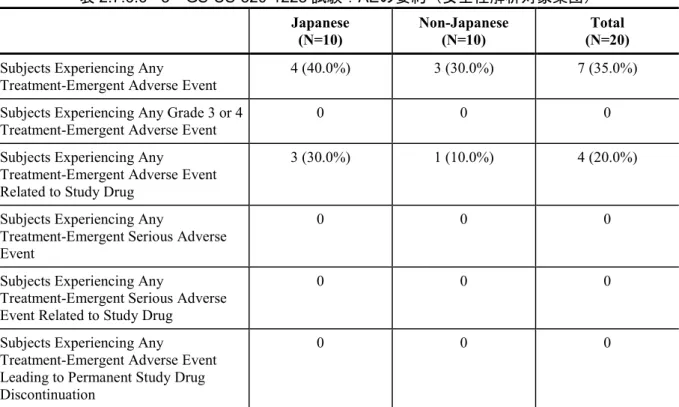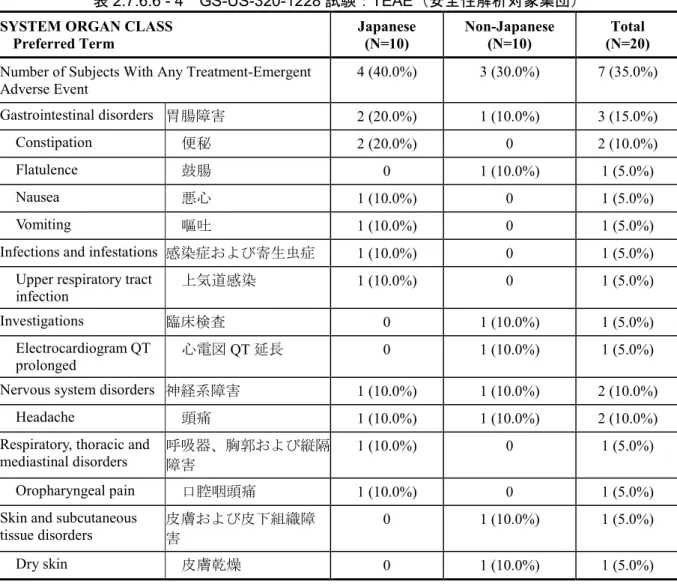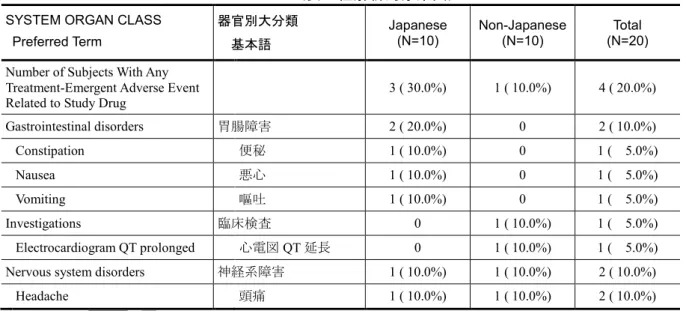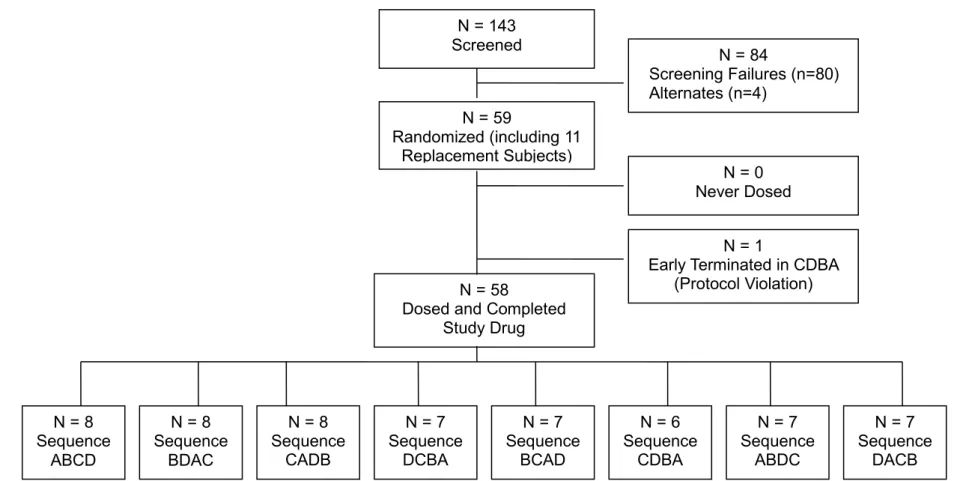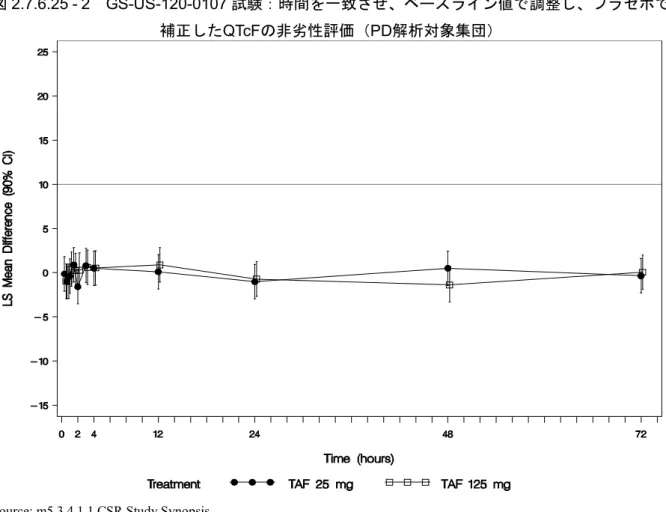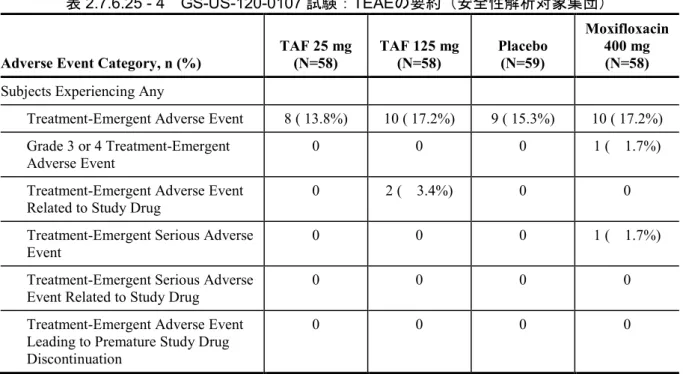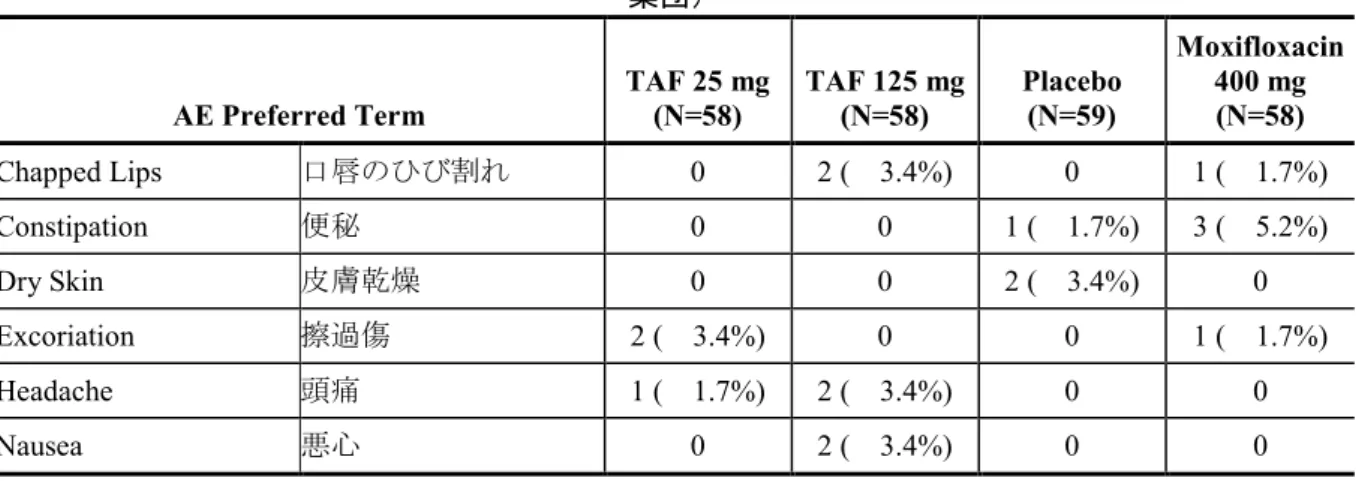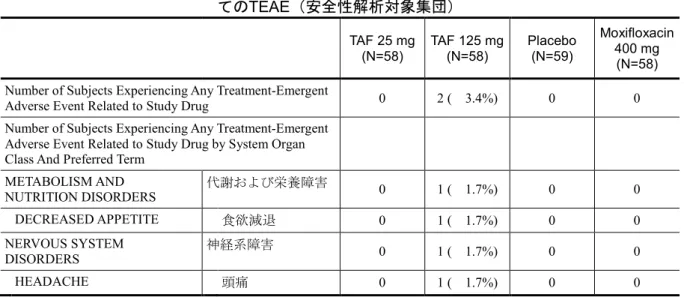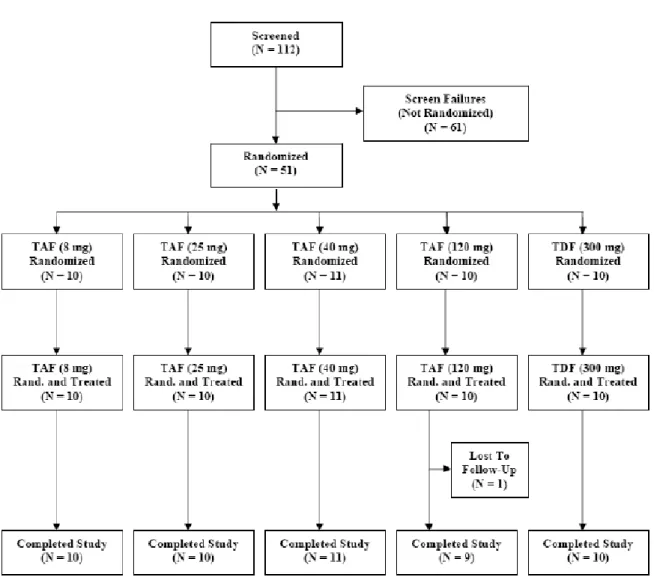ベムリディ錠
25 mg
第
2 部(モジュール 2):CTD の概要(サマリー)
2.7.6 個々の試験のまとめ
1 臨床試験一覧
Type ofStudy Study Number Objective(s) Study Design Study and Control Drug Regimens Duration of Treatment Number of Subjects Study Population / Entry Criteria Type of Report Study Status;
Comparative
BA/BE GS-US-311-1088 Evaluate the bioequivalence between F/TAF FDC and FTC+TAF coadministered as individual agents Phase 1, randomized, open-label, single-dose, 2-way crossover study Subjects were randomized to 1 of 2 treatment sequences (AB or BA) and received the following treatments: • F/TAF 200/25 mg FDC PO (A) • FTC 200 mg + TAF 25 mg PO (B) 2 days (Single doses on Days 1 and 15) Enrolled: 56 Completed: 54 Safety Analysis Set: A: 56
B: 55
Healthy adult
subjects Study completed;
m5.3.1.2.1
Final CSR
Comparative
BA/BE GS-US-311-1473 Evaluate the bioequivalence of FTC and TAF administered as F/TAF FDC, or as E/C/F/TAF FDC Phase 1, randomized, open-label, single-dose, 2-way crossover study Subjects were randomized to 1 of 2 treatment sequences (AB or BA) and received the following treatments: • F/TAF 200/25 mg FDC PO (A) • E/C/F/TAF (150/150/200/ 10 mg) FDC PO (B) 2 days (Single doses on Days 1 and 7) Enrolled: 116 Completed: 116 Safety Analysis Set: A: 116
B: 116
Healthy adult
subjects Study completed;
m5.3.1.2.2
Type of
Study Study Number Objective(s) Study Design Study and Control Drug Regimens Duration of Treatment Number of Subjects Study Population / Entry Criteria Type of Report Study Status;
Comparative
BA/BE GS-US-292-0103 Evaluate the PK and relative bioavailability of EVG, COBI, FTC, TAF, and TFV administered as E/C/F/TAF FDC relative to the administration of the individual components Phase 1, randomized, open-label, single-center, multiple-dose, multiple-cohort, 2-period, crossover study
Within each cohort, subjects were randomized to 1 of 2 treatment sequences and received the following treatment: Cohort 1: • E/C/F/TAF (150/150/200/ 10 mg) QD PO (A) • EVG 150 mg + COBI 150 mg QD PO (B) Cohort 2: • E/C/F/TAF (150/150/200/ 10 mg) QD PO (A) • FTC 200 mg + TAF 25 mg QD PO (C) 24 days (12 days for each treatment period within a sequence) Randomized: 34 Completed: 33 Safety Analysis Set: Cohort 1: 14 Cohort 2: 20
Healthy adult
subjects Study completed;
m5.3.1.2.3 Final CSR Healthy Subject PK and Tolerability
GS-US-120-0109 Determine the mass balance of TAF following administration of a single, oral dose of radiolabeled [14C]TAF Phase 1, open-label, mass-balance study • TAF 25 mg (mixture of unlabeled TAF and [14C]TAF) PO
Single dose Enrolled: 8 Completed: 8 Safety Analysis Set: 8
Healthy adult male
subjects Study completed;
m5.3.3.1.1
Final CSR
Intrinsic
Factor PK GS-US-320-1228 Investigate the PK, of TAF and its metabolite TFV. Evaluate the safety and tolerability of TAF Phase 1, open-label, single-dose, single-center study
Subjects were enrolled in 1 of 2 groups (Japanese and non-Japanese) and received the following treatment.
• TAF 25 mg tablet PO
Single dose Randomized: 20 Treated: 20 Completed Study Treatment: 20 10 subjects per group
Healthy Japanese and non-Japanese subjects Study completed; m5.3.3.3.1 Final CSR
Type of
Study Study Number Objective(s) Study Design Study and Control Drug Regimens Duration of Treatment Number of Subjects Study Population / Entry Criteria Type of Report Study Status;
Intrinsic
Factor PK GS-US-120-0108 Evaluate the PK of TAF and its metabolite TFV following administration of TAF in subjects with and without severe renal impairment Phase 1, open-label, parallel-design, single-dose, PK study
• TAF 25 mg PO Single dose Enrolled: 27
Completed: 27 Safety Analysis Set: Subjects with severe renal impairment: 14 Age and sex matched controls: 13
Adult subjects with severe renal impairment (eGFRCG of 15 to ≤ 29 mL/min) or healthy matched control subjects (eGFRCG of ≥ 90 mL/min) Study completed; m5.3.3.3.2 Final CSR Intrinsic
Factor PK GS-US-120-0114 Evaluate the PK of TAF in subjects with normal and impaired hepatic function Phase 1, open-label, 2-cohort, parallel-group, single-dose, multicenter study
• TAF 25 mg PO Single dose Enrolled: 40
Completed: 40 Safety Analysis Set: Cohort 1:
Subjects with mild hepatic impairment: 10 Matched controls: 10 Cohort 2:
Subjects with moderate hepatic impairment: 10 Matched controls: 10
Cohort 1:
Adult subjects with mild hepatic impairment (CPT Class A) and healthy matched control subjects Cohort 2: Adult subjects with moderate hepatic impairment (CPT Class B) and healthy matched control subjects Study completed; m5.3.3.3.3 Final CSR Intrinsic
Factor PK GS-US-320-1615 Evaluate the PK of TAF and its metabolite TFV in subjects with normal hepatic function and subjects with severe hepatic impairment. Phase 1, open-label, parallel-group, single-dose, multicenter study
Subjects were enrolled in 1 of 2 groups (normal hepatic function or severe hepatic impairment) and received the following treatment. • TAF 25 mg tablet
PO
Single dose Randomized: 20 Treated: 20 Completed Study Treatment: 20 10 subjects per group
Adult subjects with severe hepatic impairment (CPT C) and healthy matched control subjects
Study completed;
m5.3.3.3.4
Type of
Study Study Number Objective(s) Study Design Study and Control Drug Regimens Duration of Treatment Number of Subjects Study Population / Entry Criteria Type of Report Study Status;
Extrinsic
Factor PK GS-US-120-0117 Evaluate the PK of RPV and TAF following single-dose administration of RPV and TAF alone and in combination in healthy subjects Phase 1, open-label, single-center, single-dose, crossover study
Within each cohort, subjects were randomized to 1 of 2 treatment sequences and received the following treatments: Cohort 1: • TAF 25 mg QD PO (A) • TAF 25 mg + RPV 25 mg QD PO (B) Cohort 2: • TAF 25 mg + RPV 25 mg QD PO (B) • RPV 25 mg QD PO (C) 2 days (Days 1 and 12) Randomized: 36 Completed: 36 Safety Analysis Set: Cohort 1: 18 Cohort 2: 18
Healthy adult
subjects Study completed;
m5.3.3.4.1
Type of
Study Study Number Objective(s) Study Design Study and Control Drug Regimens Duration of Treatment Number of Subjects Study Population / Entry Criteria Type of Report Study Status;
Extrinsic
Factor PK GS-US-120-0118 Evaluate the effect of common boosted PIs ATV+RTV; DRV+RTV; LPV/r, or the INSTI DTG on the PK of TAF, and evaluate the PK of ATV, DRV, LPV, and DTG alone and in combination with FTC and TAF Phase 1, open-label, DDI study Cohort 1: • FTC 200 mg + TAF 10 mg QD PO (Day 1) (A) • ATV 300 mg + RTV 100 mg QD PO (Days 2-14) (B) • A + B (Day 15) Cohort 2: • FTC 200 mg + TAF 10 mg QD PO (Day 1) (A) • DRV 800 mg + RTV 100 mg QD PO (Days 2-14) (C) • A + C (Day 15) Cohort 3: • FTC 200 mg + TAF 10 mg QD PO (Day 1) (A) • LPV/r (4 × 200/50 mg) QD PO (Days 2-14) (D) • A + D (Day 15) Cohort 4: • FTC 200 mg + TAF 10 mg QD PO (Day 1) (F) • DTG 50 mg QD PO (Days 2-14) (E) • F + E (Day 15) 15 days Enrolled: 40 Completed: 39 Safety Analysis Set: Cohort 1: 10 Cohort 2: 10 Cohort 3: 10
Cohort 4: 10 (1 subject excluded from the FTC+TAF+DTG safety analysis)
Healthy adult
subjects Study completed;
m5.3.3.4.2
Type of
Study Study Number Objective(s) Study Design Study and Control Drug Regimens Duration of Treatment Number of Subjects Study Population / Entry Criteria Type of Report Study Status;
Extrinsic
Factor PK GS-US-120-1538 Evaluate the PK and drug interaction potential between TAF and MDZ (Oral and IV)
Phase 1, open-label, multiple-dose, single-center study
Subjects received the following treatments in a fixed sequence under fed conditions in the morning: • Day 1: MDZoral 2.5 mg syrup (A) • Day 3: MDZIV 1 mg solution (B) • Days 4-15 and 17: TAF 25 mg PO (C) • Day 16: TAF 25 mg PO + MDZoral 2.5 mg syrup coadministered (D) • Day 18: TAF 25 mg PO + MDZIV 1 mg solution administered within 5 min of each other (E) 18 days (Day 1, washout on Day 2, and doses on Days 3-18) Enrolled: 18 Completed: 18 Safety Analysis Set: A: 18 B: 18 C: 18 D: 18 E: 18 F: 18 Healthy adult
subjects Study completed;
m5.3.3.4.3
Type of
Study Study Number Objective(s) Study Design Study and Control Drug Regimens Duration of Treatment Number of Subjects Study Population / Entry Criteria Type of Report Study Status;
Extrinsic
Factor PK GS-US-120-1554 Evaluate the PK and drug interaction potential between TAF and RPV Phase 1, open-label, randomized, fixed-sequenc e, 2-cohort, 2-period, multiple-dose study
Within each cohort, subjects were randomized to 1 of 2 treatment sequences and received the following treatments under fed conditions: Cohort 1: • TAF 25 mg QD PO (Days 1-14) (A) • TAF 25 mg + RPV 25 mg QD PO (Days 15-28) (C) Cohort 2: • RPV 25 mg QD PO (Days 1-14) (B) • TAF 25 mg + RPV 25 mg QD PO (Days 15-28) (C) 28 days Randomized: 34 Completed: 32 Safety Analysis Set: Cohort 1: 17 Cohort 2: 17
Healthy adult
subjects Study completed;
m5.3.3.4.4
Final CSR
Extrinsic
Factor PK GS-US-292-0110 Evaluate the effect of food (high-calorie/ high-fat meal or light/low-fat meal) on the PK of TAF when administered as E/C/F/TAF FDC Phase 1, randomized, open-label, single-center, 3-period, 6-sequence, crossover, food-effect study Subjects were randomized to 1 of 6 treatment sequences and received E/C/F/TAF (150/150/200/10 mg) QD PO administered under the following meal conditions: • Fasted (A) • Light/low-fat meal (B) • High-calorie/ high-fat meal (C) 15 days (study drug was administere d on Days 1, 8, and 15) Randomized: 43 Completed: 42 Safety Analysis Set: 43
Healthy adult
subjects Study completed;
m5.3.3.4.5
Type of
Study Study Number Objective(s) Study Design Study and Control Drug Regimens Duration of Treatment Number of Subjects Study Population / Entry Criteria Type of Report Study Status;
Extrinsic
Factor PK GS-US-292-1316 Evaluate the PK of EVG, TAF, and SER following the coadministration of E/C/F/TAF FDC and SER relative to the administration of E/C/F/TAF or SER alone Phase 1, open-label, 3-period, fixed-sequenc e, single-center study • SER 50 mg QD PO (Day 1) (A) • E/C/F/TAF (150/ 150/200/10 mg) QD PO (Days 2-13) (B) • SER 50 mg + E/C/F/TAF (150/ 150/200/10 mg) QD PO (Day 14) (C) 14 days Enrolled: 20 Completed: 19 Safety Analysis Set: 20
Healthy adult
subjects Study completed;
m5.3.3.4.6
Type of
Study Study Number Objective(s) Study Design Study and Control Drug Regimens Duration of Treatment Number of Subjects Study Population / Entry Criteria Type of Report Study Status;
Extrinsic
Factor PK GS-US-311-0101 Cohort 1: Evaluate the PK of TAF, TFV, and FTC following once-daily coadministration of F/TAF FDC and EFV relative to the administration of F/TAF FDC alone Cohorts 2 and 3: Evaluate the PK of TAF, TFV, FTC, COBI, and DRV following once-daily coadministration of F/TAF FDC and DRV+COBI relative to the administration of these agents alone Cohort 4: Evaluate the PK of TAF, TFV, and COBI following once-daily coadministration of TAF+COBI relative to the administration of TAF alone Phase 1, non-randomiz ed, open-label, crossover, multicohort, multiple-dose study Cohort 1: • F/TAF (200/40 mg) QD PO (Days 1-12, fasted) (A) • F/TAF (200/40 mg) + EFV 600 mg QD PO (Days 13-26, fasted) (B) Cohort 2: • F/TAF (200/25 mg) QD PO (Days 1-12, fed) (C) • F/TAF (200/25 mg) + DRV 2 × 400 mg + COBI 150 mg QD PO (Days 13-22, fed) (D) Cohort 3: • DRV 2 × 400 mg + COBI 150 mg QD PO (Days 1-10, fed) (E) • F/TAF (200/25 mg) + DRV 2 × 400 mg + COBI 150 mg QD PO (Days 11-22, fed) (F) Cohort 4: • TAF 8 mg QD PO (Days 1-12, fed) (G) • TAF 8 mg + COBI 150 mg QD PO (Days 13-22, fed) (H) Cohort 1: 26 days Cohorts 2-4: 22 days Enrolled:50 Completed: 48 Safety Analysis Set: A: 12 B: 12 C: 12 D: 25a E: 14 F: n/a G: 12 H: 12 Healthy adult
subjects Study completed;
m5.3.3.4.7
Type of
Study Study Number Objective(s) Study Design Study and Control Drug Regimens Duration of Treatment Number of Subjects Study Population / Entry Criteria Type of Report Study Status;
Extrinsic
Factor PK GS-US-311-1386 Determine the effect of food on the PK of TAF and FTC when administered as F/TAF FDC Phase 1, randomized, open-label, single-dose, 2-period, crossover study Subjects were randomized to 1 of 2 treatment sequences (AB or BA) and received the following treatments: • F/TAF 200/25 mg FDC PO fasted (A) • F/TAF 200/25 mg FDC PO fed (B) 2 days (Single doses on Days 1 and 8) Enrolled: 40 Completed: 38 Safety Analysis Set: A: 40
B: 38
Healthy adult
subjects Study completed;
m5.3.3.4.8
Final CSR
Extrinsic
Factor PK GS-US-311-1388 Evaluate the effect of ATV+COBI on the PK of TAF and its metabolite TFV, and FTC. Evaluate the effect of TAF on the PK of ATV+COBI. Evaluate the safety and tolerability of F/TAF and ATV+COBI administered together or separately Phase 1, open-label, fixed-sequenc e, 3-period, single-center, cross-over study
Subjects received the following treatments with food. • F/TAF (200/10 mg) (A) • ATV 300 mg + COBI 150 mg + F/TAF (200/10 mg) QD (B) • ATV 300 mg + COBI 150 mg QD (C) Treatment A: 7 days (Days 1-7) Treatment B: 7 days (Days 8-14) Treatment C: 7 days (Days 15-21 ) Randomized: 20 Treated: 20 Completed Study Treatment: 20 Healthy adult
subjects Study completed;
m5.3.3.4.9
Type of
Study Study Number Objective(s) Study Design Study and Control Drug Regimens Duration of Treatment Number of Subjects Study Population / Entry Criteria Type of Report Study Status;
Extrinsic
Factor PK GS-US-311-1790 Evaluate the effect of F/TAF FDC tablet or GS-9883 on the PK of a representative hormonal contraceptive medication, norgestimate/ ethinyl estradiol. Evaluate the safety and tolerability of F/TAF FDC or GS-9883 when given with a representative hormonal contraceptive medication, norgestimate/ ethinyl estradiol. Phase 1, randomized, open-label, single-center, fixed-sequenc e, multiple-dose, multiple-coho rt study Part A: Lead-in
period (Lead-in Days 1–28) with Ortho Tri-Cyclen Lo (OC) QD Part B: Cycle 1: OC QD for Study Days 1–28 Cycle 2: Subjects were randomized to 1 of 2 cohorts and received the following treatments:
• Cohort 1: OC QD
for Study Days 29– 56 plus F/TAF 200/25 mg on Study Days 29–42 • Cohort 2: OC QD
for Study Days 29– 56 plus GS-9883 75 mg on Study Days 29–42 All treatments were administered QD in the morning with food.
84 days Randomized: 32 Treated: 32 Completed Study Treatment: Cohort 1: 13 Cohort 2: 15 Healthy adult
women subjects Study complete; m5.3.3.4.10
Final CSR
Extrinsic
Factor PK GS-US-320-1382 Evaluate the effect of food on the PK of TAF. Evaluate the safety and tolerability of TAF Phase 1, randomized, open-label, single-center, 2-period, crossover study Subjects were randomized to 1 of 2 sequences (AB or BA) and received the following treatments. • TAF 25 mg tablet PO under fasted conditions (A) • TAF 25 mg tablet PO with a high-fat meal (B) 2 days (single dose on Day 1, and single dose on Day 8) Randomized: 40 Treated: 40 Completed Study Treatment: 39 20 subjects per group
Healthy adult
subjects Study completed;
m5.3.3.4.11
Type of
Study Study Number Objective(s) Study Design Study and Control Drug Regimens Duration of Treatment Number of Subjects Study Population / Entry Criteria Type of Report Study Status;
Extrinsic
Factor PK GS-US-342-1167 Evaluate the PK of SOF and metabolites GS-566500 and GS-331007, and GS-5816 upon administration of SOF/GS-5816 FDC with ATR STR, CPA STR, DTG, or E/C/F/TAF, and evaluate the PK of COBI, DTG, EFV, EVG, FTC, RPV, TAF and/or TFV upon administration of ATR, CPA, DTG, or E/C/F/TAF with SOF/GS-5816 FDC Phase 1, open-label, multiple-dose, 4-cohort study Cohorts 1-3: Subjects were randomized to treatments that did not include E/C/F/TAF. Cohort 4:
Subjects were randomized to 1 of 6 treatment sequences and received the following treatments with a moderate fat meal: • SOF/GS-5816 (400/100 mg) QD PO (8 days) (J) • E/C/F/TAF (150/ 150/200/10 mg) QD PO (8 days) (K) • SOF/GS-5816 (400/100 mg) + E/C/F/TAF (150/ 150/200/10 mg) QD PO (8 days) (L) Cohort 4:
24 days Randomized to Cohort 4: 24 Completed: 23 Safety Analysis Set: 24
Healthy adult
subjects Study completed;
m5.3.3.4.12
Type of
Study Study Number Objective(s) Study Design Study and Control Drug Regimens Duration of Treatment Number of Subjects Study Population / Entry Criteria Type of Report Study Status;
Extrinsic
Factor PK GS-US-366-1689 Evaluate the PK of FTC, RPV, TAF, LDV, SOF, and the SOF metabolites GS-566500 and GS-311007 when coadministered as FTC/RPV/TAF FDC with LDV/SOF FDC Phase 1, randomized, open-label, multiple-dose, 3-way, 6-sequence crossover study Subjects were randomized to 1 of 6 treatment sequences (ABC, ACB, BAC, BCA, CAB, or CBA) and received the following treatments: • LDV/SOF 90/400 mg FDC PO (A) • FTC/RPV/TAF 200/25/25 mg FDC PO (B) • LDV/SOF 90/400 mg + FTC/RPV/TAF 200/25/25 mg FDC PO (C) 33 days total (Regimens A, B, and C administere d 11 days each) Randomized: 42 Completed: 41 Safety Analysis Set: 42 A: 42
B: 42 C: 42
Healthy adult
subjects Study completed;
m5.3.3.4.13
Type of
Study Study Number Objective(s) Study Design Study and Control Drug Regimens Duration of Treatment Number of Subjects Study Population / Entry Criteria Type of Report Study Status;
Extrinsic
Factor PK GS-US-292-0101 Evaluate the relative bioavailability of EVG, COBI, FTC, and TFV when administered as 1 of 2 formulations of E/C/F/TAF FDC vs STB STR and TAF alone
Phase 1, randomized, open-label, single-center, multiple-dose, multiple-coho rt study
Within each cohort, subjects were randomized to 1 of 4 treatment sequences and received the following treatment: Cohort 1: • Formulation 1 E/C/F/TAF (150/ 150/200/25 mg) QD PO (A) • Formulation 1 E/C/F/TAF (150/ 150/200/40 mg) QD PO (B) • STB STR (150/150/200/300 mg) QD PO (C) • TAF 25 mg QD PO (D) Cohort 2: • Formulation 2 E/C/F/TAF (150/ 150/200/25 mg) QD PO (E) • Formulation 2 E/C/F/TAF (150/ 150/200/40 mg) QD PO (F) • STB STR (150/ 150/200/300 mg) QD PO (C) • TAF 25 mg QD PO (D) 54 days (4 12-day treatment sequences with a 2-day washout period between each sequence) Randomized: 40 Completed: 36 Safety Analysis Set: Cohort 1: 20 Cohort 2: 20
Healthy adult
subjects Study completed;
m5.3.3.4.14
Type of
Study Study Number Objective(s) Study Design Study and Control Drug Regimens Duration of Treatment Number of Subjects Study Population / Entry Criteria Type of Report Study Status;
Extrinsic
Factor PK GS-US-311-1387 (Part A) Evaluate the effect of CBZ on the PK of TAF and TFV when administered as F/TAF FDC. To evaluate the safety and tolerability of F/TAF FDC when administered alone or with CBZ Phase 1, open-label, adaptive, 2-part, 3-period, fixed sequence, single-center study
Subjects received the following treatments in a fed state: • F/TAF FDC (200/25 mg), single dose, Day 1 • CBZ 100 mg BID, Days 6-8 • CBZ 200 mg BID, Days 9-11 • CBZ 300 mg BID, Days 12-25 • CBZ 300 mg BID + F/TAF FDC (200/25 mg) single dose, Day 26 26 days (2 single doses of F/TAF on Days 1 and 26, and CBZ on Days 6-26) Randomized: 26 Treated: 26 Completed Study Treatment: 22 Healthy adult
subjects Study ongoing; m5.3.3.4.15
Interim CSR
Healthy Subjects PK and PK/PD
GS-US-120-0107 Evaluate the effects of TAF (at therapeutic and supratherapeutic doses) and its metabolite TFV on time-matched, baseline-adjusted, placebo-corrected QTcF Phase 1, randomized, partially-blind ed, placebo- and positive-contr olled, 4-period, single-dose crossover study Subjects were randomized to 1 of 8 treatment sequences and received the following treatments: • TAF 25 mg + 4 × placebo-to-mat ch TAF QD PO (A) • TAF 125 mg (5 × 25 mg) QD PO (B) • Placebo-to-match TAF (C) • Moxifloxacin 400 mg PO, administered open-label (D) 37 days (4 single-do se treatment days separated by 11 days of washout between doses) Randomized: 59 Completed: 58 Safety Analysis Set: A: 58
B: 58 C: 59 D: 58
Healthy adult
subjects Study completed;
m5.3.4.1.1
Type of
Study Study Number Objective(s) Study Design Study and Control Drug Regimens Duration of Treatment Number of Subjects Study Population / Entry Criteria Type of Report Study Status;
Patient PD and
PK/PD GS-US-320-0101 Evaluate the short-term antiviral activity of TAF and compare with TDF. Characterize the viral dynamics of HBV DNA associated with the use of TAF. Investigate the PK of TFV and TAF. Phase 1b, randomized, open-label, active-controll ed study Subjects were randomized to receive the following treatments. • TAF 8 mg QD PO • TAF 25 mg QD PO • TAF 40 mg QD PO • TAF 120 mg QD PO • TDF 300 mg QD PO 28 days Randomized: 51 Treated: 51 Completed Study Treatment: 51 10 subjects per group (11 subjects TAF 40 mg group) Treatment-naive adults with CHB infection Study completed; m5.3.4.2.1 Final CSR Patient PD and
PK/PD GS-US-120-0104 Evaluate the short-term antiviral potency of TAF 8 mg, 25 mg, and 40 mg compared to placebo-to-match TAF or TDF 300 mg Phase 1, randomized, partially-blind ed, active- and placebo-contr olled study • TAF 8 mg QD PO (A) • TAF 25 mg QD PO (B) • TAF 40 mg QD PO (C) • TDF 300 mg QD PO (D) • Placebo-to-match TAF QD PO (E) 10 days Randomized: 40 Completed: 37 Safety Analysis Set: A: 9 B: 8 C: 8 D: 6 E: 7 HIV-infected adult subjects, who had not received ART within 90 days of screening 320-0108 Study completed; m5.3.4.2.2 Final CSR
Type of
Study Study Number Objective(s) Study Design Study and Control Drug Regimens Duration of Treatment Number of Subjects Study Population / Entry Criteria Type of Report Study Status;
Patient PD and
PK/PD GS-US-292-0102 Evaluate the safety and efficacy of a regimen containing E/C/F/TAF administered as FDC tablet vs E/C/F/TDF (Stribild®, STB) administered as a FDC tablet in HIV infected, ART naive adult subjects Phase 2, randomized, double blinded study Subjects were randomized in a 2:1 ratio to 1 of the following 2 treatment groups: • FDC of EVG 150 mg/COBI 150 mg/FTC 200 mg/TAF 10 mg + placebo-to-match STB once daily (n = 100) • FDC of EVG 150 mg/COBI 150 mg/FTC 200 mg/TDF 300 mg + placebo-to-match E/C/F/TAF once daily (n = 50) After Week 48, subjects continued to take their blinded study drug until treatment assignments were unblended. At the unblinding visit, subjects were given the option to receive E/C/F/TAF in an OL extension. 48 weeks of double-blind ed treatment after which subjects continued to take their blinded study drug until treatment assignments were unblinded, at which point all subjects were given the option to receive E/C/F/TAF in the OL extension phase. Randomized: 171 Treated: 170 E/C/F/TAF: Treated: 112 Completed randomized treatment: 105 Ongoing in OL Phase: 104 STB: Treated: 58 Completed randomized treatment: 53 Ongoing in OL Phase: 53
HIV infected adults with plasma HIV-1 RNA levels ≥ 5000 copies/mL, no prior use of any approved or experimental anti HIV drug
Study ongoing;
m5.3.4.2.3
Type of
Study Study Number Objective(s) Study Design Study and Control Drug Regimens Duration of Treatment Number of Subjects Study Population / Entry Criteria Type of Report Study Status;
Controlled Clinical Studies Pertinent to the Claimed Indication
GS-US-320-0108 Evaluate the safety and efficacy of TAF 25 mg QD vs TDF 300 mg QD for the treatment of HBeAg-negative CHB Phase 3, randomized, double-blind, multicenter study Subjects were randomized in a 2:1 ratio to 1 of the following 2 treatment groups. • TAF 25 mg tablet QD and matched placebo of TDF 300 mg QD (A) • TDF 300 mg QD and matched placebo of TAF 25 mg QD (B) This double-blind treatment period was followed by an open-label extension period where subjects received the following treatment. • TAF 25 mg QD 96 weeks of double-blind treatment followed by 48 weeks of open-label treatment Randomized: 426 Treated: 425 TAF: Treated: 285 Completed double-blind treatment: 4 On-going with randomized treatment: 269 TDF: Treated: 140 Completed double-blind treatment: 1 On-going with randomized treatment:132 Treatment-naive and treatment-experience d adult HBeAg-negative CHB subjects Study ongoing; m5.3.5.1.1 Interim CSR
Type of
Study Study Number Objective(s) Study Design Study and Control Drug Regimens Duration of Treatment Number of Subjects Study Population / Entry Criteria Type of Report Study Status;
Controlled Clinical Studies Pertinent to the Claimed Indication
GS-US-320-0110 Evaluate the safety and efficacy of TAF 25 mg QD vs TDF 300 mg QD for the treatment of HBeAg-positive CHB Phase 3, randomized, double-blind, multicenter study Subjects were randomized in a 2:1 ratio to 1 of the following 2 treatment groups. • TAF 25 mg tablet QD and matched placebo of TDF 300 mg QD (A) • TDF 300 mg QD and matched placebo of TAF 25 mg QD (B) This double-blind treatment period was followed by an open-label extension period where subjects received the following treatment. • TAF 25 mg QD 96 weeks of double-blind treatment followed by 48 weeks of open-label treatment Randomized: 875 Treated: 873 Completed Study Treatment up to data cut date: 844 TAF: Treated: 581 Completed double-blind treatment: 14 On-going with randomized treatment: 537 TDF: Treated: 292 Completed double-blind treatment: 8 On-going with randomized treatment: 270 Treatment-naive and treatment-experience d adult HBeAg-positive CHB subjects Study ongoing; m5.3.5.1.2 Interim CSR
ART = antiretroviral therapy; ARV = antiretroviral; ATR = efavirenz/emtricitabine/tenofovir disoproxil fumarate (coformulated; Atripla®); ATV = atazanavir; BA = bioavailability;
BE = bioequivalence; BID = twice daily; 14C = radiolabeled carbon 14; CBZ = carbamazepine; COBI = cobicistat (Tybost®); CHB = chronic hepatitis B;
CPA = emtricitabine/rilpivirine/tenofovir disoproxil fumarate (coformulated; Complera®); CPT = Child-Pugh-Turcotte; CSR = clinical study report; DDI = drug-drug interaction; DNA =
deoxyribonucleic acid; DRV = darunavir; DTG = dolutegravir; E/C/F/TAF = elvitegravir/cobicistat/emtricitabine/tenofovir alafenamide (coformulated); EFV = efavirenz; eGFRCG =
estimated glomerular filtration rate calculated using the Cockcroft-Gault equation; EVG = elvitegravir (Vitekta®); FDC = fixed-dose combination; F/TAF = emtricitabine/tenofovir
alafenamide (coformulated); FTC = emtricitabine (Emtriva®); FTC/RPV/TAF = emtricitabine/rilpivirine/tenofovir alafenamide (coformulated); HBeAg = hepatitis B e antigen; HBV =
hepatitis B virus; HIV = human immunodeficiency virus; INSTI = integrase strand-transfer inhibitor; IV = intravenous; LDV = ledipasvir; LDV/SOF = ledipasvir/sofosbuvir (coformulated; Harvoni®); LPV = lopinavir; LPV/r = lopinavir boosted with ritonavir; MDZ = midazolam; OC = Ortho Tri-Cyclen Lo; PD = pharmacodynamics; PI = protease inhibitor;
PK = pharmacokinetic(s); PO = orally; QD = once daily; QT = electrocardiographic interval between the beginning of the Q wave and termination of the T wave, representing the time for both ventricular depolarization and repolarization to occur; QTcF = QT interval corrected for heart rate using the Fridericia formula; RPV = rilpivirine; RTV = ritonavir; SER = sertraline; SOF = sofosbuvir; STB = elvitegravir/cobicistat/emtricitabine/tenofovir disoproxil fumarate (coformulated; Stribild®); STR = single-tablet regimen; TAF = tenofovir alafenamide;
TDF = tenofovir disoproxil fumarate (Viread®); TFV = tenofovir
2 GS-US-311-1088 試験
(参考資料:第5.3.1.2.1項) 本試験は、エムトリシタビン/テノホビル アラフェナミド配合錠の生物学的同等性を評価する 第1 相、ランダム化、オープンラベル、単回投与、2-way クロスオーバー試験であった。 試験の概要を表2.7.6.2 - 1に示す。 表2.7.6.2 - 1 GS-US-311-1088 試験:試験の概要 試験番号 GS-US-311-1088 試験の標題 エムトリシタビン/テノホビル アラフェナミド配合錠の生物学的同等性を評 価する第1 相、ランダム化、オープンラベル、単回投与、2-way クロスオーバー 試験 開発の相 第1 相 目的 本試験の主要目的は以下のとおりであった。 • エムトリシタビン/テノホビル アラフェナミド(F/TAF)配合錠と、エ ムトリシタビン(FTC)及び TAF 各単剤の併用投与(FTC + TAF)の生物 学的同等性を評価する。 本試験の副次目的は以下のとおりであった。 • FTC 及び TAF を配合錠として単回経口投与したときと単剤として併用投 与したときの安全性及び忍容性を評価する。 試験デザイン 本第1 相、ランダム化、オープンラベル、単回投与、2-way クロスオーバー試 験では、F/TAF と、FTC + TAF 各単剤の併用投与の生物学的同等性を健康被験 者を対象として評価した。スクリーニング及びDay −1 の試験手順後に適格と なった被験者を2 つの投与順(AB 又は BA)のいずれかにランダム割付けし、 以下の治験薬を投与した(Day 1 に 1 回及び Day 15 に 1 回)。 • 投与 A:F/TAF(200/25 mg)配合錠を食後に単回経口投与 • 投与 B:FTC 200 mg カプセルと TAF 25 mg 錠を食後に単回経口投与 被験者はDay −1 から Day 7 の朝まで治験実施医療機関に入院した。Day 14 に 治験実施医療機関に再来院し、Day 21 の朝まで再入院した。被験者は Day 10 及びDay 29 に電話による追跡調査を受けた。 診断及び主な選 択基準 被験者の適格基準は、18~45 歳の健康な男性及び妊婦又は授乳婦以外の女性 で、体格指数(BMI)が 19~30 kg/m2、Cockcroft-Gault 式による推算糸球体ろ 過率(eGFRCG)が70 mL/min 以上であることとした。 被験者数(計画時 及び解析時) 計画時:約56 例(評価可能被験者 50 例) ランダム割付:56 例(全ランダム化解析対象集団) 評価可能:薬物動態(PK)では分析対象物質(TAF 及び FTC)ごとに 55 例、 安全性ではF/TAF 投与で 56 例及び FTC + TAF 投与で 55 例 被験薬、用量、用 法及びロット番 号 F/TAF(200/25 mg)配合錠(投与 A)を一晩絶食後、朝食後に経口投与 ロット番号:対照治療、用量、 用法及びロット 番号 FTC 200 mg カプセル及び TAF 25 mg 錠(投与 B)を一晩絶食後、朝食後に経 口投与 FTC 200 mg ロット番号: TAF 25 mg ロット番号: 投与期間 治験薬はDay 1 及び Day 15 に投与した。 評価基準 有効性:本試験では、有効性を評価していない。 薬物動態:PK 解析用の経時的な血液検体を Day 1 及び Day 15 の治験薬投与日 の次の時点で採取した:0(投与前)、投与後 5 分、15 分、0.5、0.75、1、1.5、 2、3、4、5、8、12、24、48、72、96、120 及び 144 時間。FTC 及び TAF の主 要なPK パラメータとして次を算出した:AUClast、AUCinf及びCmax。副次的 PK パラメータとして次を算出した:Tmax、Clast、Tlast、λz、%AUCexp、t1/2、CL/F 及びVz/F。 安全性:安全性評価は、有害事象のモニタリング、併用薬、臨床検査、定期的 な身体的検査、身長、体重、心電図及びバイタルサインの記録又は測定により 実施した。 解析方法 有効性:本試験では、有効性解析を実施していない。 薬物動態:血漿中濃度及びPK パラメータは一覧表を作成し、記述統計を用い て治験薬別に要約した。さらに、個々の被験者でのPK パラメータのデータに ついて、幾何平均値、95%信頼区間(CI)、自然対数変換後の平均値及び標準 偏差(SD)を算出した。 F/TAF と FTC + TAF の生物学的同等性を評価するために、PK パラメータ(自 然対数変換したAUCinf、AUClast及びCmax)を比較した。混合効果モデルを用 いたパラメトリック分散分析を自然対数変換したPK パラメータに適用した。 2 つの投与間の PK パラメータの幾何平均比(GMR)の 90% CI を算出した。 選択したPK パラメータ(AUCinf、AUClast及びCmax)のGMR の 90% CI が事 前に規定した生物学的同等性の範囲80%~125%に含まれる場合、両製剤は生 物学的に同等であると結論づけた。 安全性:安全性データは、記述統計を用いて要約した。有害事象は、ICH 国際 医薬用語集(MedDRA)Version 17.0 を用いて読み替えた。 実施医療機関 米国の単施設 試験実施期間 20 年 月 日(最初の被験者のスクリーニング日) 20 年 月 日(最後の被験者の最終観察日)
結果の要約 被験者の内訳及び被験者背景: 本試験でランダム割付けされた被験者は計56 例であり、54 例が試験を完了した。1 例は、治験実 施計画書からの逸脱(ウォッシュアウト期間中の薬物スクリーニング陽性)のために本試験を中 止した。もう1 例は、すべての予定された PK 評価を終える前の Day 29 に同意を撤回した。 安全性解析対象集団での被験者の平均年齢は35 歳(範囲:20~45 歳)であった。被験者の半数が 男性であった。被験者の大多数が白人(82.1%)で、それ以外は黒人(17.9%)であった。また、 被験者の92.9%がヒスパニック系/ラテン系であった。ベースライン時の BMI の平均値(SD)は 25.8(2.71) kg/m2で、eGFRCGの平均値(SD)は 123.7(19.77) mL/min であった。 有効性の結果: 本試験では有効性の評価は実施しなかった。 薬物動態の結果:
TAF 及び FTC の血漿中 PK パラメータの AUClast、AUCinf及びCmaxの統計比較(被験薬F/TAF vs 対照薬FTC+TAF)を次表に示す。 GLSMs by Treatment GLSM Ratio (%) 90% CI (%) Test Treatment (F/TAF) (N = 55) Reference Treatment (FTC+TAF) (N = 55) TAF PK Parameter AUClast (ng•h/mL) 245.91 239.48 102.68 (95.78, 110.09) AUCinf (ng•h/mL) 254.18a 240.33b 105.77 (97.26, 115.01) Cmax (ng/mL) 209.36 226.11 92.59 (82.31, 104.16) FTC PK Parameter AUClast (ng•h/mL) 9049.70 9410.78 96.16 (94.29, 98.08) AUCinf (ng•h/mL) 9259.49 9636.68 96.09 (94.24, 97.96) Cmax (ng/mL) 1813.87 1727.84 104.98 (100.75, 109.39)
GLSM = geometric least-squares mean N = 43
N = 48
Source: m5.3.1.2.1 CSR Study Synopsis
2 つの投与間でプロファイルは同様であった。すべてのパラメータが、事前に規定した生物学的同 等性の範囲80%~125%内であった。 安全性の結果: 本試験中に重篤な有害事象、死亡、妊娠はみられず、有害事象のために治験薬の投与を中止した 被験者はいなかった。 有害事象が認められた被験者の割合は、F/TAF 投与で 10.7%(6/56 例)、FTC + TAF 投与で 14.5% (8/55 例)であった。F/TAF 投与後に 2 例以上に認められた有害事象はなかった。FTC + TAF 投 与後に2 例以上に認められた有害事象は、医原性損傷(外傷性静脈穿刺が 2 例、3.6%)のみであっ た。 すべての有害事象はGrade 1 であった。治験薬と関連ありと判断された有害事象はなかった。 本試験中に臨床検査値及びバイタルサインで臨床的に重要な変化は認められなかった。
結論 本試験の全体的な結論は以下のとおりである。 • F/TAF 配合錠(200/25 mg)は、単剤として併用投与した FTC 200 mg 及び TAF 25 mg と生物 学的に同等である。 • F/TAF 配合錠(200/25 mg)及び FTC 200 mg + TAF 25 mg は、健康被験者において概ね安全で 良好な忍容性を示した。
3 GS-US-311-1473 試験
(参考資料:第5.3.1.2.2項) 本試験は、エムトリシタビン/テノホビル アラフェナミド(200/25 mg)配合錠とエルビテグ ラビル/コビシスタット/エムトリシタビン/テノホビル アラフェナミド(150/150/200/10 mg) 配合錠の間でエムトリシタビン及びテノホビル アラフェナミドの生物学的同等性を評価する、第 1 相、ランダム化、オープンラベル、単回投与、2-way クロスオーバー試験であった。 試験の概要を表2.7.6.3 - 1示す。 表2.7.6.3 - 1 GS-US-311-1473 試験:試験の概要 試験番号 GS-US-311-1473 試験の標題 エムトリシタビン/テノホビル アラフェナミド(200/25 mg)配合錠とエルビ テグラビル/コビシスタット/エムトリシタビン/テノホビル アラフェナミ ド(150/150/200/10 mg)配合錠の間でエムトリシタビン及びテノホビル アラフ ェナミドの生物学的同等性を評価する、第1 相、ランダム化、オープンラベル、 単回投与、2-way クロスオーバー試験 開発の相 第1 相 目的 本試験の主要目的は以下のとおりであった。 • エムトリシタビン(FTC;F)及びテノホビル アラフェナミド(TAF)の 生物学的同等性を、F/TAF(200/25 mg)配合錠又はエルビテグラビル (EVG;E)/コビシスタット(COBI;C)/FTC/TAF(E/C/F/TAF) (150/150/200/10 mg)配合錠の投与で評価する。 本試験の副次目的は以下のとおりであった。• EVG、COBI、FTC 及び TAF を配合錠(E/C/F/TAF 及び F/TAF)として単回 経口投与したときの安全性及び忍容性を評価する。
試験デザイン 本試験は、FTC 及び TAF の生物学的同等性を、F/TAF 配合錠又は E/C/F/TAF 配 合錠として投与し判定する、ランダム化、オープンラベル、単回投与、2-way クロスオーバー試験であった。スクリーニング及びDay −1 の治験手順の後に、 被験者を2 つの投与順序(AB 又は BA)のいずれか一方にランダム割付けし、 Day 1 及び Day 7 に以下(A 又は B)のいずれか一方を単回投与した。
• 投与 A: F/TAF(200/25 mg)配合錠を食後に単回経口投与する。 • 投与 B: E/C/F/TAF(150/150/200/10 mg)配合錠を食後に単回経口投与す る。 被験者はDay −1 から Day 13 まで治験実施医療機関に入院した。被験者は Day 21 ± 2 日[治験薬最終投与後 14(±2)日]に電話による追跡調査を受けた。 診断及び主な選 択基準 適格被験者は、18 歳以上 45 歳以下の健康な男性及び女性(妊婦及び授乳婦は 除く)で、体格指数(BMI)が 19~30 kg/m2、重大な病歴がなく、クレアチニ ンクリアランス[Cockcroft-Gault 式による推算糸球体ろ過率(eGFRCG)]が 70 mL/min 以上、スクリーニング評価時に治験担当医師により全身健康状態が 良好であることが確認された者とした。
被験者数(計画時 及び解析時) 計画時:116 例[各投与順(AB 及び BA)に 58 例を登録し、各投与順にそれぞ れ52 例の評価可能例を得ることを目標とした] ランダム割付時:116 例(投与順序 AB に 58 例;投与順序 BA に 58 例) 解析時:116 例[安全性解析対象集団、及び TAF、FTC、EVG、COBI の薬物動 態(PK)解析対象集団] 被験治療、用量、 用法及びロット 番号 F/TAF(200/25 mg)配合錠を食後に単回経口投与する。 ロット番号: 対照薬、用量、用 法及びロット番 号 E/C/F/TAF(150/150/200/10 mg)配合錠を食後に単回経口投与する。 ロット番号: 投与期間 22 日間(Day 1 及び Day 7 の治験薬単回投与、投与間の 6 日間の休薬期間及び 14 日間の追跡調査期間) 評価基準 有効性:本試験では、有効性の評価は実施していない。 薬物動態:PK 評価用の連続血液検体を Day 1 及び Day 7 の投与後の以下の時点 で採取した:0(投与前)、5 分、15 分、0.5、0.75、1、1.5、2、3、4、5、8、12、 24、48、72、96、120、144 時間(Day 7 の投与前に採取した投与後 144 時間の 検体を除き、すべて投与後に採取した)。以下の血漿中PK パラメータを算出し た:Cmax、Tmax、λz、Clast、Tlast、t1/2、AUClast、AUCinf、%AUCexp、Vz/F、CL/F。 安全性:安全性評価は、有害事象のモニタリング、併用薬、臨床検査、定期的 な身体的検査、身長、体重、心電図(ECG)及びバイタルサインの測定値によ り実施した。 解析方法 有効性:本試験では、有効性の評価は実施していない。 薬物動態:血漿中濃度及びPK パラメータは一覧表を作成し、記述統計を用い て投与群別に要約した。さらに、クロスオーバーデザインに適切な混合効果モ デルを用いたパラメトリック分散分析(ANOVA)を、自然対数変換した PK パ ラメータ(AUCinf、AUClast、Cmax)に適用した。TAF と FTC の各 PK パラメー タについて、幾何最小二乗平均(GLSM)比の両側 90%信頼区間(CI)を算出 した。F/TAF 配合錠中の FTC 及び TAF と E/C/F/TAF 配合錠中の FTC 及び TAF 成分の生物学的同等性については、2 製剤間で各分析物の PK パラメータの GLSM比の90% CIが、事前に規定した生物学的同等性の範囲である80%~125% に含まれる場合、両製剤は生物学的に同等と判定した。 安全性:安全性データは記述統計を用いて要約した。有害事象はICH 国際医薬 用語集Version 17.0 を用いて読み替えた。 実施医療機関 米国の単施設 試験実施期間 20 年 月 日(最初の被験者のスクリーニング日) 20 年 月 日(最後の被験者の最終観察日)
結果の要約 被験者の内訳及び被験者背景: 計116 例が本試験でランダム割付けされ、治験薬を少なくとも 1 回投与され、試験を完了した。被 験者の大半は男性(65.5%)、白人(53.4%)及びヒスパニック系/ラテン系(54.3%)であった。ベ ースライン時、年齢の中央値は33 歳(範囲:18~45 歳)、BMI の中央値[第一四分位(Q1)、第三 四分位(Q3)]は 25.9(24.0、27.9)kg/m2及びeGFRCG(クレアチニンクリアランス)の中央値(Q1、 Q3)は 112.2(101.0、132.9) mL/min であった。 薬物動態の結果:
TAF 及び FTC の血漿中 PK パラメータの統計比較(F/TAF 200/25 mg vs E/C/F/TAF 150/150/200/10 mg) を次表に示す。 TAF PK Parameter N Test Mean (%CV) N Mean (%CV) Reference GLSM Ratio (Test/Reference) (%) 90% CI (%)
F/TAF (200/25 mg) (Test) vs E/C/F/TAF (150/150/200/10 mg) (Reference)
AUClast (h*ng/mL) 116 374.0 (43.4) 116 369.3 (40.6) 100.32 96.48, 104.31 AUCinf (h*ng/mL) 95 396.4 (42.6) 97 389.5 (39.3) 98.54 94.61, 102.62 Cmax (ng/mL) 116 280.5 (62.9) 116 267.8 (59.8) 103.63 95.46, 112.49 FTC PK Parameter N Test Mean (%CV) N Mean (%CV) Reference GLSM Ratio (Test/Reference) (%) 90% CI (%)
F/TAF (200/25 mg) (Test) vs E/C/F/TAF (150/150/200/10 mg) (Reference)
AUClast
(h*ng/mL) 116 9423.9 (19.3) 116 10475.3 (19.7) 90.01 88.88, 91.16 AUCinf
(h*ng/mL) 116 9654.6 (19.3) 116 10706.6 (19.6) 90.20 89.06, 91.35 Cmax (ng/mL) 116 1577.4 (26.8) 116 1601.7 (19.6) 97.26 94.57, 100.03
Source: m5.3.1.2.2 CSR Study Synopsis
TAF 及び FTC について、AUClast、AUCinf、CmaxのGLSM 比とその 90% CI は、事前に規定した生物 学的同等性の値である80%~125%の範囲内であった。TAF の Tmaxの中央値は同じ(1.50 時間)で あったが、FTC の Tmaxの中央値は、F/TAF(200/25 mg)投与後が 2.00 時間であったのに対し、 E/C/F/TAF 投与後では 3.00 時間であった。 安全性の結果: 本試験において、2 つの治験薬は同程度の安全性を示した。死亡、治験薬中止に至った有害事象又 はGrade 4 の有害事象の報告はなかった。1 件の重篤な有害事象の腹膜出血が F/TAF 投与後に報告 された。本事象はGrade 3 であり、治験担当医師により治験薬と関連なしと判断された。この Grade 3 の有害事象の腹膜出血を除き、他のすべての有害事象の重症度はGrade 1 又は 2 であった。 治験薬投与期間中に2 例以上で報告された有害事象は、悪心、頭痛、便秘、嘔吐、下痢、浮動性め まい、緊張性頭痛及び歯痛であった。
本試験期間中、1 件の Grade 4 及び 2 件の Grade 3 の臨床検査値異常が認められた。被験者 1 例は Grade 4 のリパーゼ増加の臨床検査値異常(及び同日の Grade 2 のアミラーゼ増加)がみられたが、 この被験者から有害事象は報告されなかった。女性被験者2 例に Grade 3 の血尿がみられ、そのう ち1 例はその時月経中であったことが確認されている。観察された他のすべての臨床検査値異常は Grade 1 又は 2 であった。 腎機能パラメータ(血清クレアチニン、eGFRCG 及び血清リン酸塩)にベースラインからの臨床的 に重要な変化はいずれの投与群においても認められなかった。さらに、TAF の主要代謝物である尿 酸の濃度についても、ベースラインからの臨床的に重要な変化は認められなかった。 本試験期間中、バイタルサイン測定値に臨床的に重要な変化は認められなかった。本試験期間中、 妊娠は認められなかった。 結論
• F/TAF(200/25 mg)配合錠の FTC 及び TAF 成分は、E/C/F/TAF(150/150/200/10 mg)配合錠の FTC 及び TAF 成分と生物学的に同等である。
• F/TAF(200/25 mg)配合錠及び E/C/F/TAF(150/150/200/10 mg)配合錠の単回投与は、本試験 においておおむね良好な忍容性を示した。
4 GS-US-292-0103 試験
(参考資料:第5.3.1.2.3項) 本試験は、エルビテグラビル/コビシスタット/エムトリシタビン/GS-7340 単一錠剤レジメ ン(STR)の、個別成分のコビシスタットでブーストしたエルビテグラビル、エムトリシタビン 及びGS-7340 に対する相対的バイオアベイラビリティを評価する、第 1 相反復投与試験であった。 試験の概要を表2.7.6.4 - 1に示す。 表2.7.6.4 - 1 GS-US-292-0103 試験:試験の概要 試験番号 GS-US-292-0103 試験の標題 エルビテグラビル/コビシスタット/エムトリシタビン/GS-7340 単一錠剤 レジメン(STR)の、個別成分のコビシスタットでブーストしたエルビテグラ ビル、エムトリシタビン及びGS-7340 に対する相対的バイオアベイラビリティ を評価する第1 相反復投与試験 開発の相 第1 相 目的 GS-US-292-0103 試験の目的は、健康被験者を対象として、エルビテグラビル (EVG)/コビシスタット(COBI)/エムトリシタビン(FTC)/GS-7340 配合錠の単一錠剤レジメン(STR)と STR の成分を別々に投与したときの、 EVG、COBI、FTC、GS-7340 及びテノホビル(TFV)の薬物動態及び相対的バ イオアベイラビリティを評価することであった。また、本試験のもう一つの目 的はEVG/COBI/FTC/GS-7340 STR の安全性及び忍容性を個々の成分と比較し て評価することであった。 本試験の主要目的は以下のとおりであった。 • EVG/COBI/FTC/GS-7340 STR、並びに個別成分の EVG、COBI、FTC 及び GS-7340 を投与したときの EVG、COBI、FTC、GS-7340 及び TFV の薬物 動態及び相対的バイオアベイラビリティを評価する。 本試験の副次目的は以下のとおりであった。 • EVG/COBI/FTC/GS-7340 STR、並びに個別成分である EVG、COBI、FTC 及びGS-7340 の安全性及び忍容性を評価する。 試験デザイン 本試験は、健康成人被験者を対象とした、単施設、ランダム化、オープンラベ ル、反復投与、複数コホート、2 期クロスオーバー試験であった。適格被験者 をコホート1 又はコホート 2 のいずれかに割付け、各コホートに 18~45 歳の 健康な男女(妊婦、授乳婦は除く)がほぼ均等に分布するようにした。以下の 治験薬を投与した。 コホート1 投与A:EVG 150 mg/COBI 150 mg/FTC 200 mg/GS-7340 10 mg を含む STR 投与B:EVG 150 mg + COBI 150 mg コホート2 投与A:EVG 150 mg/COBI 150 mg/FTC 200 mg/GS-7340 10 mg を含む STR 投与C:FTC 200 mg + GS-7340 25 mg 各治験薬は1 日 1 回、朝食とともに 12 日間経口投与した。 各コホート内で、被験者を1:1 の比率で Sequence I 又は Sequence II の投与順 にランダム割付けし、以下の投与を行った。Period 1 Period 2
Day 34
Cohort 1 Days 1-12 Days 13-24
Sequence I A B Follow-up Sequence II B A Cohort 2 Sequence I A C Sequence II C A
Source: m5.3.1.2.3 CSR Study Synopsis
診断及び主な選 択基準 被験者の適格基準は、男性及び妊婦又は授乳婦以外の女性で、年齢18~45 歳、 体格指数(BMI)が 19 kg/m2以上30 kg/m2以下、12 誘導心電図(ECG)が正常、 腎機能が正常で、重大な病歴がなく、治験薬の初回投与予定日前28 日以内の スクリーニング評価で治験担当医師の判断により健康状態が良好であること とした。 被験者数(計画 時及び解析時) コホート1 計画時:14 例(評価可能例 12 例を得る) 解析時(解析対象集団別): • 安全性解析対象集団:14 例 • EVG、COBI、FTC、GS-7340 及び TFV 薬物動態(PK)解析対象集団:14 例 コホート2 計画時:20 例(評価可能例 16 例を得る) 解析時(解析対象集団別): • 安全性解析対象集団:20 例 • EVG、COBI、FTC、GS-7340 及び TFV PK 解析対象集団:19 例 被験薬、用量、 用法及びロット 番号 投与A EVG 150 mg/COBI 150 mg/FTC 200 mg/GS-7340 10 mg を含む STR を 1 日 1 回、 朝食とともに経口投与;ロット番号 対照治療、用量、 用法及びロット 番号 投与B EVG 150 mg + COBI 150 mg を 1 日 1 回、朝食とともに経口投与 ロット番号 EVG: ;COBI: 投与C FTC 200 mg + GS-7340 25 mg を 1 日 1 回、朝食とともに経口投与 ロット番号 FTC: ;GS-7340: 投与期間 24 日間 評価基準 有効性:本試験では、有効性は評価しなかった。 薬物動態:EVG、COBI、FTC、GS-7340 及び TFV の血漿中濃度をバリデート された生体試料分析法を用いて測定した。EVG、COBI、FTC、GS-7340 及び TFV について以下の様々な血漿中 PK パラメータを算出した。
AUCtau、AUClast、AUCinf、%AUCexp、Cmax、Clast、Ctau、Tmax、Tlast、t½及びλz
安全性:安全性は、臨床検査、Cockcroft-Gault 式による推算糸球体ろ過率 (eGFRCG)、ECG、定期的な身体的検査(バイタルサインを含む)及び有害事
象の記録により評価した。
解析方法 有効性:本試験では、有効性の評価は実施しなかった。
薬物動態:各コホートの各分析対象物について、薬物動態パラメータを、記述 統計量を用いて投与群別に要約した。さらに、クロスオーバーデザインに適切 な混合効果モデルを用いたパラメトリック(正規理論)分散分析を、自然対数 変換したAUCtau/AUClast、Cmax及びCtauに適用した。以下の解析対象の各薬物動 態パラメータ(EVG、COBI、FTC、TFV については AUCtau、Cmax、Ctau;GS-7340 についてはAUClast、Cmax)の2 投与間の幾何平均比の 90%信頼区間(CI)を算 出した。
Analyte Parameter
Comparison
Test Reference Boundary No Effect
EVG
COBI AUCtau EVG/COBI/FTC/GS-7340 10 mg Treatment A in Cohort 1 Multiple Dose EVG + COBI Treatment B in Cohort 1 Multiple Dose 70% to 143% Cmax Ctau FTC
TFV AUCtau EVG/COBI/FTC/GS-7340 10 mg Treatment A in Cohort 2 Multiple Dose FTC + GS-7340 25 mg Treatment C in Cohort 2 Multiple Dose 70% to 143% Cmax Ctau
GS-7340 AUClast EVG/COBI/FTC/GS-7340 10 mg Treatment A in Cohort 2 Multiple Dose FTC + GS-7340 25 mg Treatment C in Cohort 2 Multiple Dose 70% to 143% Cmax
Source: m5.3.1.2.3 CSR Study Synopsis
安全性:治験薬初回投与日の当日から治験薬最終投与日の30 日後までに収集 されたすべての安全性データを、記述統計量を用いて投与別に要約した。安全 性の要約では、コホート1 及びコホート 2 で投与 A を受けた被験者から得られ たデータを統合した。有害事象は、ICH 国際医薬用語集を用いて読み替えた。 実施医療機関 米国の単施設 試験実施期間 20 年 月 日(最初の被験者のスクリーニング日) 20 年 月 日(最後の被験者の最終観察日) 結果の要約 被験者の内訳及び被験者背景: 計34 例の健康被験者を本試験に組み入れ、コホート 1(14 例)又はコホート 2(20 例)のいずれ かに計画どおりにランダム割付けした。各コホートのすべての被験者に治験薬を少なくとも1 回 投与した。コホート1 のすべての被験者及びコホート 2 の 20 例中 19 例が、計画されたすべての 治験薬投与を受け、試験を完了した。コホート2 の被験者番号 2687-2017 は、FTC と GS-7340 25 mg (投与C)の単回投与後に治験参加継続への同意を撤回したため、EVG、COBI、FTC、GS-7340 及びTFV PK 解析対象集団から除外した。 コホート1 及びコホート 2 の被験者の年齢の中央値はそれぞれ 26 歳及び 36 歳であり、非ヒスパ ニック及びラテンアメリカ系の被験者の割合はそれぞれ57%及び 65%であった。その他の特性と
して、性別(約71%が男性)、人種(約 59%が白人、41%が黒人)、体重(ベースラインでの全体 平均値、74.9 kg)、BMI(ベースラインでの全体平均値、25.2 kg/m2)及びeGFRCG(ベースライン での全体平均値、126.9 mL/min)に関しては、この 2 つのコホートは類似していた。 有効性の結果: 本試験では、有効性の評価は実施しなかった。 薬物動態の結果:
EVG/COBI/FTC/GS-7340 10 mg、EVG + COBI 及び EVG + GS-7340 25 mg の投与後の GS-7340、TFV、 EVG、COBI 及び FTC の主要な PK 曝露量パラメータと、各投与間の統計学的比較を以下に示す。
GS-7340
PK Parameter Mean (%CV)Test Mean (%CV)Reference
Geometric Least-Squares Means Ratio (%) (90% CI) Cohort 2 EVG/COBI/FTC/GS-7340 10 mg (Test) vs FTC + GS-7340 25 mg (Reference) (N = 19) AUClast (ng•h/mL) 250.2 (24.7) 278.2 (28.8) 91.42 (84.12, 99.35) Cmax (ng/mL) 176.9 (35.1) 179.5 (33.9) 98.68 (84.57, 115.13) TFV
PK Parameter Mean (%CV)Test Mean (%CV)Reference
Geometric Least-Squares Means Ratio (%) (90% CI) Cohort 2 EVG/COBI/FTC/GS-7340 10 mg (Test) vs FTC + GS-7340 25 mg (Reference) (N = 19) AUCtau (ng•h/mL) 324.2 (15.4) 265.9 (22.2) 123.63 (116.97, 130.67) Cmax (ng/mL) 19.6 (13.9) 19.2 (76.0) 114.16 (97.52, 133.64) Ctau (ng/mL) 11.4 (17.8) 9.2 (23.5) 125.37 (117.72, 133.51) EVG PK Parameter Test Mean (%CV) Reference Mean (%CV) Geometric Least-Squares Means Ratio (%) (90% CI) Cohort 1 EVG/COBI/FTC/GS-7340 10 mg (Test) vs EVG + COBI (Reference) (N = 14)
AUCtau (ng•h/mL) 22067.1 (26.3) 23099.2 (22.7) 94.87 (91.51, 98.36)
Cmax (ng/mL) 1943.5 (23.9) 2161.0 (27.0) 90.32 (85.07, 95.89)
COBI PK Parameter Test Mean (%CV) Reference Mean (%CV) Geometric Least-Squares Means Ratio (%) (90% CI) Cohort 1 EVG/COBI/FTC/GS-7340 10 mg (Test) vs EVG + COBI (Reference) (N = 14)
AUCtau(ng•h/mL) 11209.8 (27.4) 10931.2 (25.5) 102.00 (98.10, 106.06) Cmax (ng/mL) 1560.7 (26.1) 1489.4 (23.2) 104.07 (99.41, 108.94) Ctau (ng/mL) 34.6 (85.5) 26.7 (62.1) 116.43 (102.05, 132.83) FTC PK Parameter Test Mean (%CV) Reference Mean (%CV) Geometric Least-Squares Means Ratio (%) (90% CI) Cohort 2 EVG/COBI/FTC/GS-7340 10 mg (Test) vs FTC + GS-7340 25 mg (Reference) (N = 19) AUCtau(ng•h/mL) 12352.6 (13.5) 10520.9 (13.8) 117.57 (113.72, 121.55) Cmax (ng/mL) 1947.0 (21.2) 1788.8 (19.2) 108.99 (102.81, 115.55) Ctau (ng/mL) 107.4 (25.8) 87.5 (20.6) 121.26 (114.66, 128.24)
Source: m5.3.1.2.3 CSR Study Synopsis
本試験において、GS-7340 10 mg(減量用量)を EVG/COBI/FTC/GS-7340 STR の構成要素として投 与したときのGS-7340 及びその代謝物である TFV の曝露量は、GS-7340 25 mg の投与(FTC との 併用投与)したときに観察された曝露量と同程度であった。このことから、GS-7340 を COBI と併 用投与したとき又はEVG/COBI/FTC/GS-7340 STR の構成要素として投与したときに観察された曝 露量がGS-7340 単剤を投与したときと比較して 2~3 倍に増加した(GS-US-311-0101 試験及び GS-US-292-0101 試験)結果が裏付けられた。この曝露量の増加は、COBI が P 糖蛋白を介した GS-7340 の腸管内への分泌を阻害しているためと考えられる(GS-US-311-0101 試験及び GS-US-292-0101 試験)。 特に、EVG/COBI/FTC/GS-7340 10 mg(被験治療)を投与したときの GS-7340 及び TFV の曝露量 のFTC + GS-7340 25 mg(対照治療)投与に対する幾何最小二乗平均(GLSM)比の 90% CI は、 治験実施計画書に定めた相互作用なしの範囲(70%~143%)内に含まれた。 EVG/COBI/FTC/GS-7340 10 mg 及び FTC + GS-7340 25 mg 反復投与後の TFV 曝露量パラメータ (AUC 及び Cmax)の平均値[パーセント変動係数(%CV)]は、EVG/COBI/FTC/テノホビル ジソ プロキシルフマル酸塩(TDF)STR 投与後に観察された値より 90%超低かった[TFV の平均(%CV) AUCtau及びCmaxは、それぞれ4066.2(24.1) ng•h/mL 及び 485.6(31.1) ng/mL;GS-US-236-0110 試験]。
EVG/COBI/FTC/GS-7340 10 mg 投与後の EVG、COBI 及び FTC について、EVG + COBI 又は FTC + GS-7340 25 mg 投与と比較した GLSM 比及び 90% CI はすべて、治験実施計画書に定めた相互作用 なしの範囲(70%~143%)内に含まれ、臨床的に意義のある差がないことが示された。より厳密 な基準範囲(80%~125%)を用いた場合も EVG、COBI 及び FTC に関するこれらの曝露量パラメ ータは基準を満たし、GS-US-292-0101 試験から以前に得られた所見と一致した。 総合すると、本試験のデータから、EVG/COBI/FTC/GS-7340 STR の臨床開発に GS-7340 の 10 mg 用量を選択することが支持される。 安全性の結果: 有害事象は、コホート1 及び 2 の EVG/COBI/FTC/GS-7340 10 mg STR(投与 A)投与期間中 33 例 中19 例(57.6%)に、コホート 1 の EVG + COBI(投与 B)投与期間中 14 例中 7 例(50.0%)に、 及びコホート2 の FTC + GS-7340 25 mg(投与 C)投与期間中 20 例中 8 例(40.0%)に報告された。 いずれかの投与で10%以上の被験者に報告された有害事象は、EVG/COBI/FTC/GS-7340 10 mg STR 投与期間中に4 例(12.1%)で報告された頭痛、EVG + COBI 投与期間中に各 2 例(14.3%)で報 告された口唇乾燥、失神寸前の状態及び鼻閉、FTC + GS-7340 25 mg 投与期間中に各 2 例(10%) で報告された頭痛及び鼻閉であった。治験担当医師により治験薬と関連ありと判断された有害事 象は、コホート1 の 1 例(7.1%)に EVG + COBI 投与期間中(そう痒症)及びコホート 2 の 1 例 (5.0%)に FTC + GS-7340 25 mg 投与期間中(皮膚炎)に報告された。有害事象の大半は Grade 1 (軽度)であり、Grade 3 又は 4 の有害事象はなかった。死亡、重篤な有害事象、有害事象による 治験薬の中止は認められなかった。 試験期間中に、Grade 1 以上の血清クレアチニン異常が発現した被験者はいなかった。血清クレア チニン平均値は試験期間を通じて基準範囲内に留まったが、EVG/COBI/FTC/GS-7340 10 mg 及び EVG + COBI 投与期間中の被験者ではベースライン値(0.9 mg/dL)からの平均増加量は 0.1 mg/dL であった。血清クレアチニン平均値の上昇は、FTC + GS-7340 25 mg 投与中の被験者では認められ なかった。EVG/COBI/FTC/GS-7340 10 mg 及び EVG + COBI の投与中の被験者では、平均で eGFRCG 値がベースラインからそれぞれ9.5 mL/min 及び 10.6 mL/min 低下した。いずれの投与についても 投与期間中に血清リン酸塩の平均値についてベースラインからの臨床的に重要な変化は認められ ず、平均値は試験期間を通じて基準範囲内であった。試験期間中に、試験治療下で発現したGrade 1 以上の血清リン酸塩異常が認められた被験者はいなかった。 試験期間中のいずれのステージに おいても尿中ブドウ糖検査で陽性を示した被験者はいなかった。Grade 1 の蛋白尿が、 EVG/COBI/FTC/GS-7340 10 mg 投与期間中の 1 例及び FTC + GS-7340 25 mg 投与期間中の 1 例で報 告された。Grade 2 の蛋白尿(血清クレアチニン濃度の上昇は認められない)が、EVG + COBI 投 与期間中の1 例から報告された。
試験期間中、バイタルサインパラメータ、身体所見又はECG プロファイルに臨床的に重要な変化 は認められなかった。
結論 薬物動態:
• EVG/COBI/FTC/GS-7340 10 mg 又は FTC + GS-7340 25 mg 投与後の TFV の平均曝露量(AUCtau 及びCmax)は、EVG/COBI/FTC/TDF STR 投与後の TFV 曝露量の過去のデータと比べて顕著 に少なかったが、EVG/COBI/FTC/GS-7340 10 mg の投与では FTC + GS-7340 25 mg と比べて GS-7340 及び TFV の曝露量は同程度となった。
• EVG/COBI/FTC/GS-7340 10 mg の投与後の EVG、COBI 及び FTC の曝露量は、EVG + COBI 及びEVG + GS-7340 25 mg の投与後に観察された曝露量と同程度であるとともに、過去に EVG/COBI/FTC/TDF STR 投与後に観察された曝露量と同程度であった。
安全性:
• EVG/COBI/FTC/GS-7340 10 mg は、健康被験者においておおむね安全で良好な忍容性を示し た。
5 GS-US-120-0109 試験
(参考資料:第5.3.3.1.1項) 本試験は、GS-7340 の薬物動態、代謝及び排泄を評価する第 1 相試験であった。 試験の概要を表2.7.6.5 - 1に示す。 表2.7.6.5 - 1 GS-US-120-0109 試験:試験の概要 試験番号 GS-US-120-0109 試験の標題 GS-7340 の薬物動態、代謝及び排泄を評価する第 1 相試験 開発の相 第1 相 目的 本試験の主要目的は以下のとおりであった。 • テノホビル アラフェナミド(TAF、旧名称 GS-7340)のマスバランスを 炭素14([14C])放射性標識 TAF の単回経口投与により検討する。 本試験の副次目的は以下のとおりであった。 • [14C]-TAF の単回経口投与後の TAF 及びその代謝物テノホビル(TFV)の 薬物動態並びに安全性を評価する。 • [14C]-TAF の単回経口投与後のヒトにおける TAF の代謝プロファイルを検 討する。 試験デザイン 本試験は、米国の単施設で実施されたオープンラベル、第1 相、マスバランス 試験で、健康被験者を対象に、[14C]-TAF の単回経口投与後の TAF の薬物動態、 代謝及び排泄を評価した。 診断及び主な選 択基準 被験者は、非喫煙男性で、年齢が18~45 歳、体格指数(BMI)が 19~30 kg/m2 で、重大な病歴がなく、腎機能が正常かつ全身状態が良好な者とした。これら は、治験薬投与前28 日以内に実施したスクリーニング評価で治験担当医師が 判断した。 被験者数(計画時 及び解析時) 計画時:8 例(評価可能例:6 例) 解析時:8 例 被験薬、用量、用 法及びロット番 号TAF 25-mg カプセル[24.15 mg の TAF 非標識体+ 100 μCi(0.85 mg)の[14C]-TAF] 治験薬は、前夜からの絶食後、標準的な食事(朝食)後5 分以内に 240 mL の 水とともに経口投与した。 ロット番号: 及び (TAF 25-mg カプセル) 対照治療、用量、 用法及びロット 番号 該当なし 投与期間 [14C]-TAF 25 mg(100 μCi)の単回経口投与後、4~21 日間の検体採取期間を設 けた。検体採取期間は、放射能の回収状況に基づき決定した。
